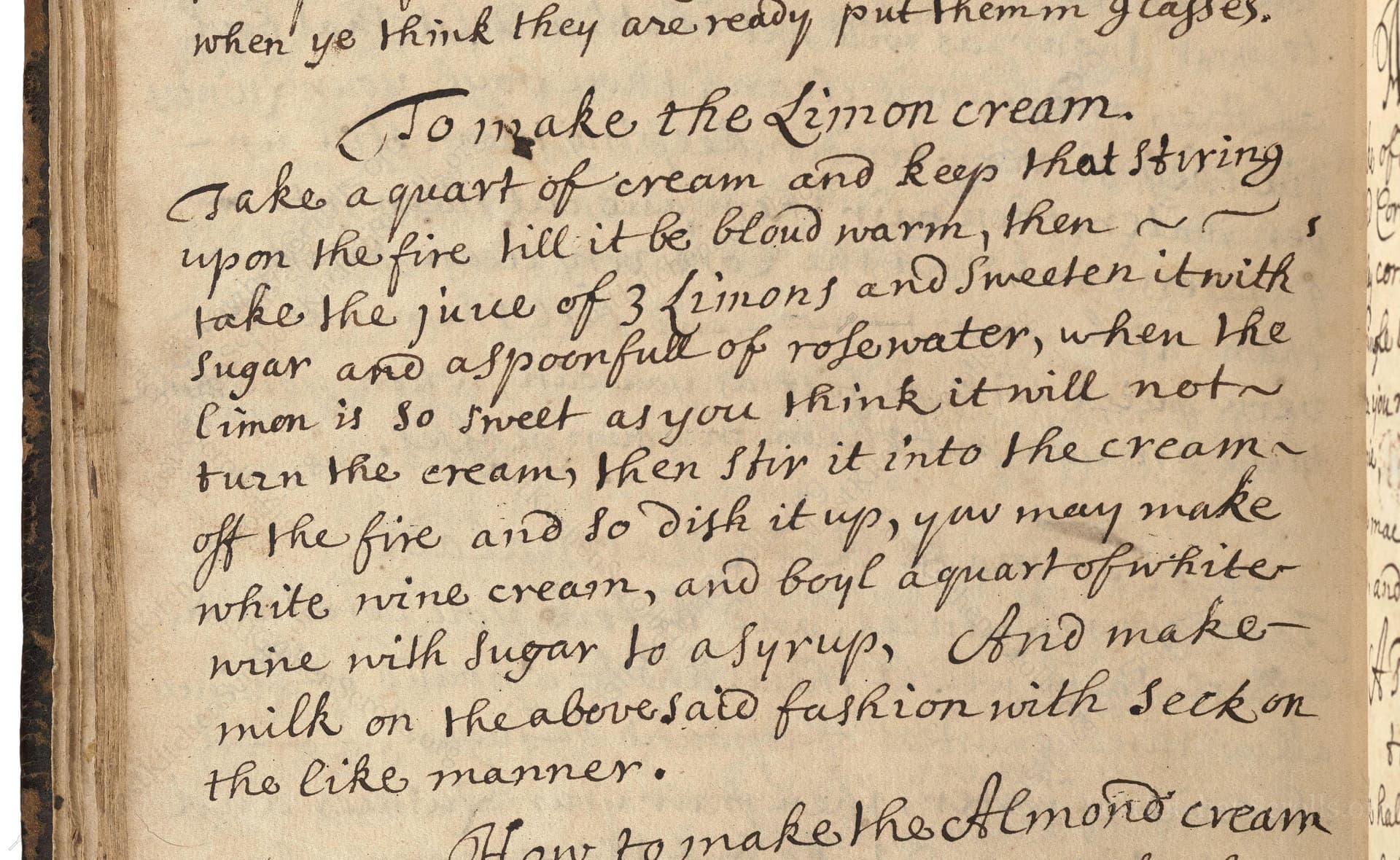To Make The Limon Cream
From the treasured pages of Cookbook
Unknown Author

To Make The Limon Cream
"Take a quart of cream and keep that stiring upon the fire till it be bloud warm, then take the juce of 3 limons and sweeten it with sugar and a spoonfull of rosewater, when the Cimon is so sweet as you think it will not turn the cream, then stir it into the cream off the fire and so dish it up, you may make white wine cream, and boyl a quart of white wine with sugar to a syrup, And make milk on the abovesaid fashion with seck on the like manner."
Note on the Original Text
The recipe is written in the brief, conversational style typical of early 18th-century collections, assuming the reader’s familiarity with basic cookery techniques and using practical, sensory cues like 'blood warm' to indicate temperature. Spelling and word choice reflect the period ('limon' for lemon, 'iumon' in the text a likely typo, 'seck' meaning a type of sweet wine). Measurements are imprecise—'a quart' or 'the juice of 3 limons'—but the spirit is one of adaptation and personal taste, trusting the cook to make adjustments as necessary. The directions also imply a fair bit of tasting along the way!

Title
Cookbook (1706)
You can also click the book image above to peruse the original tome
Writer
Unknown
Era
1706
Publisher
Unknown
Background
Step back to the early 18th century with this charming culinary collection, brimming with period recipes that tantalize the tastebuds and offer a delicious glimpse into historic kitchens.
Kindly made available by
Folger Shakespeare Library
This recipe hails from the early 18th century, around 1706, at a time when English cookery was experiencing a transition toward luxurious dairy desserts flavored with citrus and fragrant waters. These creams were often served at affluent tables as part of a banquet or as an elegant finish to a meal, showcasing both the cook’s technical skill and access to costly imported items like lemons and rosewater. The practice of curdling dairy with acid for a set cream was part of a broader trend of experimental, whimsical desserts that delighted and surprised guests.

In the early 1700s, cooks would have used a wide-brimmed brass or copper saucepan placed over a gentle fire. Stirring was done with a wooden spoon, and the cream would be judged 'blood warm' by touch rather than thermometer. Lemon juice was squeezed fresh, and rosewater was stored in glass bottles. Creams were poured into shallow ceramic or earthenware dishes to cool and set, often presented in the finest tableware available.
Prep Time
5 mins
Cook Time
5 mins
Servings
6
We've done our best to adapt this historical recipe for modern kitchens, but some details may still need refinement. We warmly welcome feedback from fellow cooks and culinary historians — your insights support the entire community!
Ingredients
- 1 quart heavy cream (or whole milk for variation)
- Juice of 3 lemons
- 1/3–1/2 cup sugar (to taste)
- 1 tablespoon rosewater
- For wine version) 1 quart dry white wine (or substitute with 1 quart sweet sherry/muscatel for 'seck')
Instructions
- Begin with 1 quart of heavy cream, gently heating it in a saucepan while stirring, just until it's blood warm (about 98°F).
- In a separate bowl, combine the juice of 3 lemons, 1 tablespoon of rosewater, and enough sugar (start with 1/3 cup and adjust to taste) to create a sweetened lemon mixture.
- Taste the mixture; it should be sweet enough that you feel confident it won't curdle the cream (the original warning implies to avoid making it too sharp).
- Remove the warmed cream from the heat, then stir in the sweetened lemon juice and rosewater.
- Pour into serving dishes and allow to set, either at cool room temperature or in the refrigerator.
- Alternatively, you can prepare a wine cream: boil 1 quart of dry white wine with 1/2 cup sugar until slightly syrupy, then proceed in a similar fashion (note: omit the cream, use milk for a 'milk on the abovesaid fashion with seck' — seck being a historical term for a sweet Spanish wine, so you could use a sweet sherry or muscatel).
Estimated Calories
350 per serving
Cooking Estimates
Preparing this dessert is quick and simple. You only need about 5 minutes to get the ingredients ready, and another 5 minutes to gently heat the cream and mix everything together. The total cook time is short because there is no baking or long stovetop work. Each serving is rich and creamy, so the calories are based on heavy cream. This recipe makes about 6 servings.
As noted above, we have made our best effort to translate and adapt this historical recipe for modern kitchens, taking into account ingredients nowadays, cooking techniques, measurements, and so on. However, historical recipes often contain assumptions that require interpretation.
We'd love for anyone to help improve these adaptations. Community contributions are highly welcome. If you have suggestions, corrections, or cooking tips based on your experience with this recipe, please share them below.
Join the Discussion
Rate This Recipe
Dietary Preference

Den Bockfisch In Einer Fleisch Suppen Zu Kochen
This recipe hails from a German manuscript cookbook compiled in 1696, a time whe...

Die Grieß Nudlen Zumachen
This recipe comes from a rather mysterious manuscript cookbook, penned anonymous...

Ein Boudain
This recipe comes from an anonymous German-language manuscript cookbook from 169...

Ein Gesaltzen Citroni
This recipe, dating from 1696, comes from an extensive anonymous German cookbook...
Browse our complete collection of time-honored recipes



